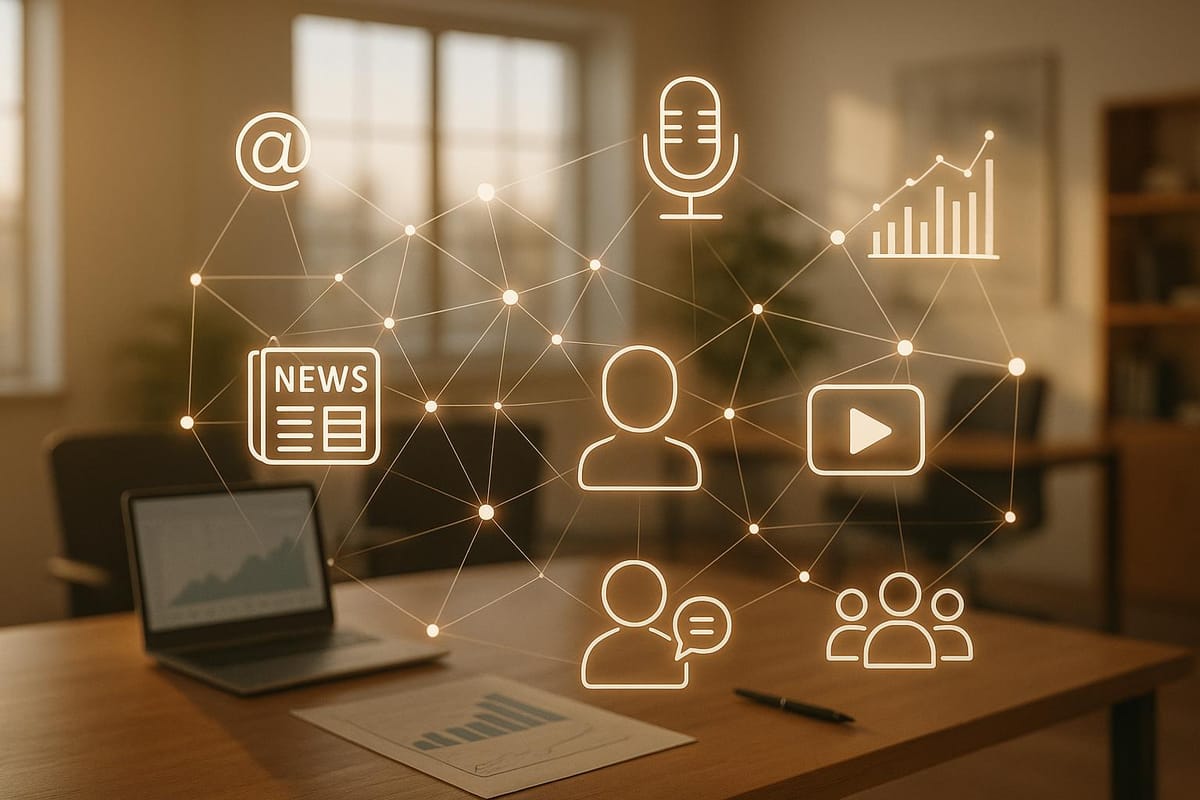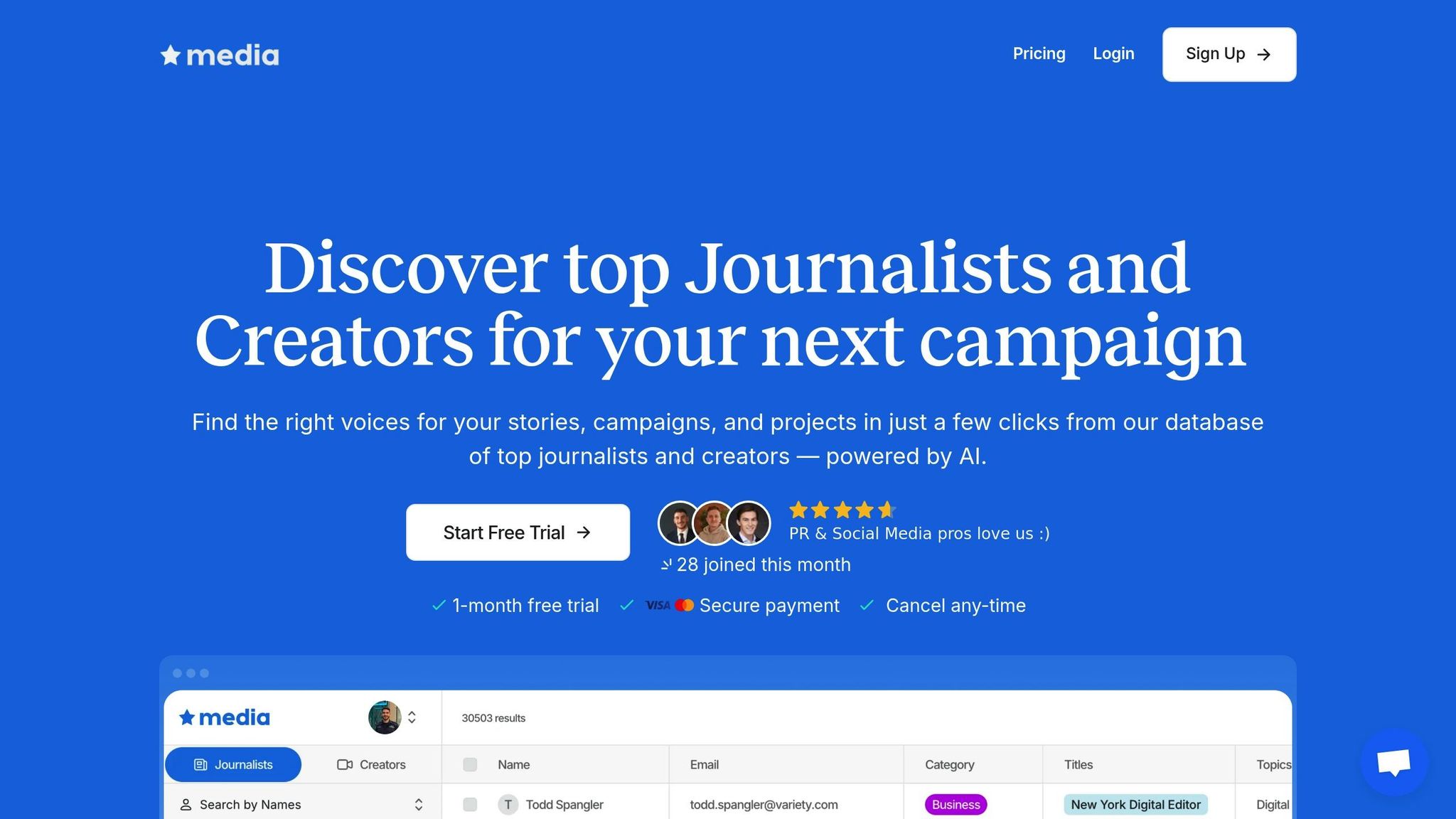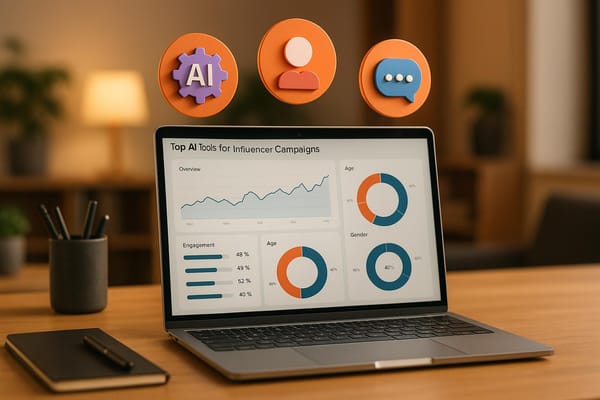How AI Analyzes Media Relationships
Explore how AI revolutionizes PR by streamlining media relationships, enhancing targeting, and improving crisis management with advanced analytics.

AI is transforming how PR professionals manage media relationships by automating tasks that used to take hours. Here's what you need to know:
- AI tools save time by analyzing journalist databases, tracking media trends, and monitoring sentiment in real time.
- Natural Language Processing (NLP) helps match journalists to stories by analyzing their writing and coverage patterns.
- Machine Learning and Predictive Analytics identify trends, improve crisis management, and optimize campaign performance.
- Real-time monitoring tracks mentions, sentiment, and new opportunities, enabling timely adjustments.
- Platforms like Media AI simplify outreach with a database of over 30,000 journalists and creators, advanced filtering options, and flexible pricing starting at $99/month.
AI-powered tools streamline PR workflows, improve targeting, and enhance decision-making. Whether you're building media lists, managing crises, or refining campaigns, AI is reshaping the way PR professionals work.
How to Win Media with AI-Powered PR
AI Technologies That Power Media Relationship Insights
Leveraging AI in media relationship management starts with understanding the technologies that drive it. Three key AI technologies form the backbone of modern PR tools, helping professionals fine-tune their media strategies.
Natural Language Processing for Media Content Analysis
Natural Language Processing (NLP) is at the heart of digital media analysis, enabling AI systems to interpret vast amounts of content like articles, social media posts, and press releases.
NLP simplifies identifying relevant media contacts. By analyzing writing styles, topic preferences, and coverage patterns, it helps match journalists with the right story ideas. Instead of manually combing through countless articles, NLP can instantly process a journalist's entire portfolio to identify their focus areas.
Major media outlets also use NLP for tasks like automated news generation, sentiment analysis, and creating multilingual content. This technology streamlines managing extensive contact databases, saving time and effort for PR teams.
Machine Learning and Predictive Analytics in PR
AI goes beyond analyzing language by using machine learning to uncover patterns and predict trends. Machine learning algorithms analyze historical data, such as past media coverage and campaign performance, to provide actionable insights.
Predictive analytics helps PR teams stay ahead of trends. For example, a 2023 study revealed that 72% of PR professionals using predictive analytics experienced better crisis prevention rates. Additionally, research from MIT's Media Lab found that AI sentiment analysis achieves 91% accuracy in detecting emotional nuances in social media posts, outperforming human analysts at 76%.
Crisis management benefits greatly from these insights. In 2017, United Airlines used predictive models to analyze social media data, quickly assessing the potential backlash during a reputation crisis. This allowed the company to respond strategically within hours. These early warning systems give PR teams the chance to act before issues spiral out of control.
"Consider AI-supported media monitoring as an example. I'd much rather spend a chunk of my day building strategy and pushing creative work than spend more time tracking down exposure", says Lindsay Scheidell, founder of Hadley PR.
Machine learning also powers attribution modeling, helping PR teams identify which actions perform best across various media channels. This data-driven approach takes the guesswork out of campaign optimization.
Real-Time Monitoring and Sentiment Tracking
Real-time monitoring tools allow PR professionals to track mentions, sentiment, and trends as they emerge, enabling timely responses and stronger media relationships.
Sentiment analysis offers immediate insights into public perception. While real-time sentiment analysis achieves 70–80% accuracy, it still provides valuable feedback on how messages are being received. Many platforms use NLP to analyze sentiment in over 100 languages, making it easier to manage global PR campaigns.
Custom notifications enhance monitoring efforts. PR teams can set up alerts for negative sentiment, helping them spot and address potential issues early. Sentiment analysis also allows teams to gauge public opinion before releasing statements, ensuring messages resonate with their target audience.
Real-time tools go beyond tracking mentions. AI algorithms can detect emotions and context in text, images, and videos across social media and news platforms. This ensures PR teams stay aware of important conversations, no matter the format.
How to Use AI Tools for PR Campaigns: Step-by-Step Guide
Using AI tools in PR campaigns can streamline your workflow and enhance your connections with journalists and creators. The secret is knowing how to use these tools effectively at every stage of your campaign.
Finding and Evaluating Journalists and Creators
AI tools take the guesswork out of building media lists by analyzing massive databases to match your campaign's needs with the right contacts. By leveraging AI's ability to scan your materials and identify relevant keywords, you can quickly pinpoint journalists and creators who align with your goals.
Upload your campaign materials for analysis. Start by uploading your press release, pitch deck, or campaign brief. This allows the AI to grasp your topic, target audience, and key messages. The system then searches journalist databases, examining past coverage and beat assignments to find ideal matches.
Dive deeper into journalists' coverage history. AI doesn't just look for keyword matches - it analyzes a journalist's articles, social media activity, and engagement metrics to assess their relevance to your campaign. This deeper analysis ensures you connect with professionals whose expertise and audience align with your story.
Media AI, for example, boasts a database of over 30,000 journalists and creators. It uses advanced algorithms to analyze coverage patterns, areas of focus, and engagement data, giving you tailored recommendations that fit your campaign's objectives.
Test your pitch with AI insights. Some tools can predict how journalists might respond to your pitch by analyzing trends and past campaign successes. This feedback helps you fine-tune your message before investing time in outreach.
If your campaign includes strong visuals, make sure your AI tool also factors in preferences for visual content.
Once you've identified potential contacts, refine your list using detailed filters to ensure precision.
Filtering and Organizing Contact Lists
After identifying potential contacts, AI can help you organize and refine your list with advanced filtering options. This ensures your outreach efforts are targeted and efficient.
Use layered filters for better precision. Start with broad categories like beat coverage, publication type, or location. Then, narrow your list further by analyzing metrics like engagement levels, follower counts, and recent activities. AI tools can process these complex combinations quickly, saving you hours of manual work.
Prioritize contacts strategically. AI tools can rank journalists based on their likelihood of covering your story, their response rates, and gaps in their current content. This prioritization ensures you focus on contacts most likely to engage with your pitch.
Platforms like Media AI allow you to segment contacts by industry focus, audience size, and engagement rates. You can even create custom lists for different phases of your campaign, tailoring your outreach to each journalist's preferences.
Export detailed lists with context. AI tools provide more than just names and email addresses. They include insights into each journalist's recent work, preferences, and the best times to reach out. This information helps you craft personalized pitches that stand out.
Prepare backup lists. If your primary contacts don't respond, AI tools can help you create alternative lists in advance. These pre-filtered options let you pivot quickly without starting your research from scratch.
Monitoring Relationships and New Opportunities
AI tools do more than track mentions - they help you maintain relationships and uncover new opportunities for collaboration. This ongoing analysis ensures you stay connected and adaptable.
Automate relationship tracking. AI dashboards monitor interactions, response rates, and coverage, helping you identify high-value relationships and contacts likely to support future campaigns.
Stay updated on journalist movements and trends. AI tools can alert you when journalists switch publications or change their coverage focus. They also highlight emerging topics and content gaps, opening doors for new collaborations.
Keep an eye on competitor coverage. AI monitoring reveals which journalists are covering your competitors and how they frame their stories. Use these insights to refine your approach and differentiate your pitch.
Get real-time alerts for new opportunities. Set up notifications to track when journalists publish content related to your industry, mention relevant topics, or express interest in new angles. These alerts ensure you never miss a chance to connect at the right time.
Additionally, AI tools can monitor social media, press releases, and industry publications to identify journalists actively seeking sources or story ideas. By positioning yourself as a resource, you stand out from the flood of generic pitches.
These AI-driven strategies help you build stronger relationships, adapt quickly, and maximize the impact of your PR campaigns.
How to Use AI Insights to Improve Campaign Performance
AI insights give PR teams a powerful advantage by identifying data patterns and audience reactions. With this information, teams can fine-tune their messaging, allocate resources more effectively, and even anticipate potential crises.
Adjusting Messages Based on Sentiment Analysis
Sentiment analysis helps PR teams understand how their messages resonate with audiences. It pinpoints which messages spark excitement and which might face resistance. By analyzing emotional reactions, AI tools provide a clearer picture of what drives engagement.
"AI-driven sentiment analysis offers the lens PR professionals need to navigate this terrain with accuracy, speed, and empathy." - Nahla Davies, Software Developer and Tech Writer
For example, if you're targeting a tech-savvy audience, they might respond well to data-heavy content. On the other hand, a broader audience could be more engaged by personal stories. One PR team promoting a sustainability initiative found that stories of personal impact resonated more than corporate milestones. This insight led them to shift their storytelling approach, resulting in stronger audience connections.
Increasing ROI Through Data-Driven Changes
AI tools can identify the most effective opportunities and help optimize resources, leading to better results. Companies using AI-driven PR strategies have seen engagement rates rise by 40%, thanks to more precise, targeted communications.
By analyzing campaign data, AI can highlight patterns that might otherwise go unnoticed. For instance, brands have reported a 30% improvement in campaign effectiveness when historical data insights were used to shape future strategies. Real-time monitoring also allows teams to focus on successful tactics while quickly adjusting underperforming ones. Setting clear goals from the start ensures AI tools can track progress and suggest timely improvements, boosting overall campaign performance.
These insights also play a key role in handling potential crises.
Managing Crises with Predictive Analytics
Predictive analytics are changing the way PR teams handle crises, shifting the focus from reactive strategies to proactive prevention. AI can analyze trends in social media, news, and industry discussions to create early warning systems that flag potential threats before they escalate.
"AI shifts crisis management from reactive to proactive, predicting and mitigating risks before they escalate." - New Horizonshighlights
During a crisis, AI helps allocate resources - like team time and budgets - based on predicted impact. Afterward, it can analyze which strategies were most effective, helping teams prepare for future challenges. For example, AI can guide real-time decisions about spokesperson availability, social media responses, and stakeholder communications. While AI predictions are invaluable, human oversight remains essential to ensure key decisions are made with expert judgment.
Why Media AI Works Best for PR Professionals

When it comes to PR, having the right tools can make all the difference. Media AI offers a centralized, constantly updated database of over 30,000 journalists and creators, helping PR professionals streamline their outreach efforts and secure better media coverage. Here's how Media AI tackles common PR challenges and makes life easier for professionals in the field.
Access to 30,000+ Journalists and Creators
One of the toughest hurdles in PR is finding the right media contacts. Media AI simplifies this by gathering essential contact information all in one place. With over 30,000 journalists and creators in its database, users can quickly identify and connect with the right people for their campaigns [27,28]. The platform provides key details like email addresses and social media profiles, enabling you to craft personalized pitches that align with each contact’s interests. This targeted approach not only strengthens relationships but also increases the chances of securing repeat media coverage.
"The core of public relations is relationship building, and it's based on a mutual respect between journalists and PR practitioners."
- Alex Slater, Founder and Managing Director, Clyde Group
Advanced Filtering and Export Tools
Media AI’s advanced search and filtering tools make it easy to zero in on the most relevant contacts. You can filter by topics, categories, job titles, media type, location, and more, ensuring your outreach is as focused as possible. Once you’ve identified your ideal contacts, the platform allows you to export this data in formats like Excel or PDF for seamless sharing and integration into your workflow. Plus, an AI-powered crawler keeps the database up to date, so you’re always reaching out to active professionals.
These features ensure your outreach is not only efficient but also highly targeted, saving time and improving results.
Flexible Pricing for All PR Professionals
Media AI’s pricing structure is designed with flexibility in mind, making it accessible to PR professionals at any level. Whether you’re a freelancer, a small agency, or part of a large firm, there’s a plan that fits your needs. Here’s a breakdown of the options:
| Plan | Monthly Price | Access | Key Benefits |
|---|---|---|---|
| Journalist Database | $99 | Full journalist contacts | Advanced filtering, export options |
| Creators Database | $99 | Full creator contacts | Advanced filtering, export options |
| Full Database | $149 | Both journalists and creators | Complete access, advanced filtering, export options |
This pricing structure ensures that even smaller organizations can use the same powerful tools as big-name PR firms. With no contracts required, you can scale your efforts depending on your budget and campaign needs. The platform’s intuitive interface also makes it easy for teams without specialized PR tech experience to get started, leveling the playing field in a competitive media environment.
Conclusion: AI Changes Everything for Media Relationships
The leap from manual media tracking to AI-driven relationship analysis marks a game-changer in the world of PR. What once took hours of effort is now accomplished in mere minutes, thanks to automated, precise insights.
This shift is reshaping how PR teams approach their work. AI now handles tasks like tracking media coverage, analyzing sentiment, and spotting trends across vast datasets. It processes information in multiple languages and formats, enabling teams to create messaging that resonates more effectively with their target audiences.
The benefits are undeniable: AI tools streamline outreach by making it more precise, improve message impact through advanced sentiment analysis, and lighten the load of manual tasks. Some platforms even interpret subtle emotional cues, allowing PR professionals to fine-tune their communication strategies. Tools like Media AI, with its extensive journalist database and advanced filtering options, give even small agencies the ability to compete on equal footing with larger firms.
Platforms such as Media AI have made professional-grade PR tools accessible to everyone. With a database of over 30,000 journalists and creators, customizable filters, and pricing starting at just $99 per month, even independent freelancers can leverage cutting-edge technology to elevate their work.
The future of media relationships is smarter, faster, and more accessible than ever. Embracing AI tools today equips PR professionals to build stronger connections, react swiftly to crises, and deliver superior results for their clients. As AI technology continues to evolve, those who adapt will gain a clear edge in navigating the increasingly intricate media landscape.
The choice is yours: will you embrace AI's potential now, or risk falling behind as the industry moves forward?
FAQs
How does AI help PR professionals create and manage media lists more effectively?
AI streamlines the creation and management of media lists by automating tasks like finding and categorizing journalists and creators who align with specific campaign objectives. It processes vast amounts of media data to match PR professionals with the best contacts, saving time and minimizing mistakes.
With its ability to quickly update and personalize media lists, AI helps ensure outreach efforts hit the mark. This is especially important in the fast-moving U.S. market, where timely and relevant communication can be the key to a campaign's success.
How does AI use Natural Language Processing (NLP) to connect journalists with the right stories?
AI uses Natural Language Processing (NLP) to dig into article content and journalist profiles, picking out key topics, keywords, and even the sentiment behind the writing. This helps match journalists with stories that align closely with their areas of expertise or personal interests.
By grasping context and the subtleties of language, NLP simplifies PR efforts. It becomes much easier to connect with the right people and create campaigns that resonate.
How does predictive analytics help PR teams manage and prevent crises?
Predictive analytics gives PR teams the ability to anticipate potential crises by examining historical data and recognizing patterns that may signal upcoming challenges. By identifying these warning signs early, teams can act swiftly to address issues before they grow into larger problems.
This method also enables organizations to model different scenarios, develop customized response plans, and make well-informed choices during high-pressure situations. Ultimately, predictive analytics plays a key role in protecting reputations, enhancing communication efforts, and reducing the fallout from unforeseen events, helping PR strategies become more prepared and adaptable.





